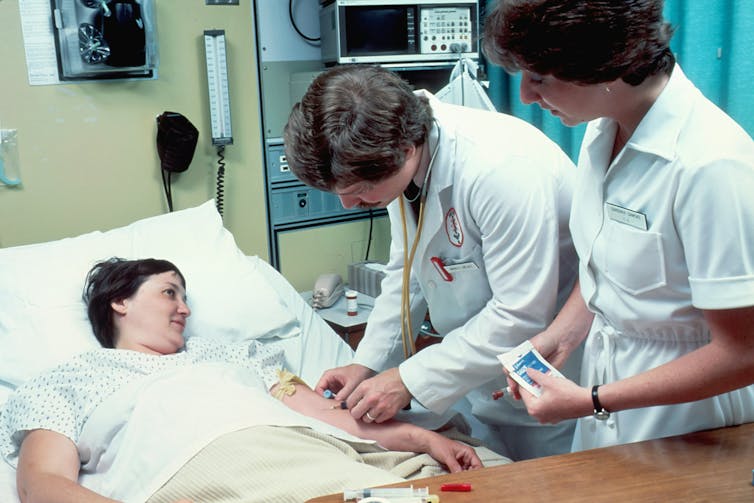Source: The Conversation (Au and NZ) – By Stephen Duckett, Honorary Enterprise Professor, School of Population and Global Health, and Department of General Practice, The University of Melbourne

Forty years ago, Medicare as we know it today was born. It was the reincarnation of the Whitlam government’s Medibank, introduced in 1975 but dismantled in stages by the Fraser Liberal government.
Medibank was developed in the 1960s by health economists Dick Scotton and John Deeble, when disease prevalence was different and the politics of reform were diabolical.
But the nation has changed since 1984, and so have our health needs. Medicare is now struggling to ensure the access to health care for millions of Australians we were once promised.
Let’s look at how we got here – and three radical changes we need to keep the Medicare promise into the future: making it cheaper to see a GP; paying less for blood and imaging tests; and covering dental care.
Read more:
If you live in a bulk-billing ‘desert’ it’s hard to see a doctor for free. Here’s how to fix this
Free hospital care, but you might pay to see a GP
One of my first jobs in the health system, in the days before Medicare and Medibank, was acting in charge of revenue collection for three public hospitals. A small subset of people could get free, albeit stigmatised, care.
We had bad debts, because some people couldn’t afford to pay their hospital bills and I was allowed by policy to recommend that some be written off. But for others I had to seek court authorisation to seize their wages to pay off their hospital debt.
Medibank changed that. Now all Australians can get public hospital care without any financial barrier.

National Cancer Institute/Unsplash
But the financial barriers to seeing a GP or a private specialist (out of hospital) have remained. Doctors continue to charge what they like, with Medicare often only covering a portion of their fees. This has left many patients facing significant out-of-pocket payments.
When Medicare was designed, medical care was provided mostly by solo medical practitioners working in practices they owned. It was a one-to-one professional relationship, with the patient paying the practitioner for each service.
Over time, general practice evolved into group practices organised as partnerships. Next, they consolidated and corporatised. A handful of corporates now provide all private pathology (which tests blood and other tissues) and radiology (which provides imaging services) and a large proportion of GP care.
Corporates have not made the same inroads into most other specialties. But since the 1980s, states have reduced public hospital outpatient services. So patients are now more reliant on private medical specialists for care referred by their GP.
Much has changed, but cost of living pressures remain
Health-care needs have changed. As we live longer, we live with more diseases, many of which are chronic. The care required increasingly involves many different health providers and includes non-medical specialties such as podiatry, physiotherapy and psychology.
When Medicare was introduced, university education was offered for only a few of these professions. But their training has evolved and so too what they can do. This is particularly the case for nursing. It has evolved from an apprenticeship model to a profession with its own specialties. A subset – nurse practitioners – have the authority to diagnose and prescribe medication.
Broader technology trends have also had an impact on health care, as with all other sectors. Virtual care and telehealth proved their worth during the early years of the COVID pandemic, just as generative AI is beginning to show its promise now.
Read more:
AI can help detect breast cancer. But we don’t yet know if it can improve survival rates
Medicare was first and foremost about efficiently removing financial barriers to access. It was introduced as part of an agreement with the Labor movement about reducing costs of living and, in particular, ensuring people could attend a doctor without having to worry about how they would pay for the visit.
However, about 1.2 million Australians deferred or missed out on seeing a GP because of cost in the 2022-23 financial year. Lower-income Australians have higher rates of missing out on care.
Medical fees aren’t regulated and so consumers face a lottery – not knowing whether a fee will be charged and having no control over that decision. Only about 52% of all Australians were always bulk-billed in 2022-23, down from 66% a year earlier.
So how can we get Medicare back on track towards its goal of universal health care for all Australians? Here are three radical reforms we should prioritise.
1. Make GP care affordable for all
Rebates are currently subject to political whim. The Liberal government (in office from 2013 to 2022) froze rebates, leading to increases in average out-of-pocket payments and reduced bulk-billing.
The first step in reducing costs as a barrier to GP care should be introduction of independent fee-setting.
Canadian Medicare – which was the model for Australia’s system – mostly has no out-of-pocket payments. Fees are set by negotiations, not politicians’ whims, and this is enshrined in legislation.
With independent fee-setting in place, a new scheme of “participating providers” should be introduced. Under such a scheme, practices would bulk-bill everyone, and participate in agreed quality-improvement programs.
Read more:
What if Medicare was restricted to GPs who bulk billed? This kind of reform is possible
If fees are set independently and fairly, extra billing over and above the fee is unjustifiable. Non-participating practices would not be eligible for Medicare benefits.
It’s anticipated the vast majority of practices would agree to participate. In Canada, the participation rate is roughly 100%, and bulk billing in Australia is still over 75%.
Participating practices should also be eligible for additional grants to employ other health professionals to provide a more comprehensive range of services – such as physiotherapists and psychologists – to meet the contemporary needs of a population with increasing chronic illness.
If successful, these changes would mean all Australians can access a GP and other primary care services without any out-of-pocket costs.
2. Deal with diagnostics

Testalize.me/Unsplash
Despite the evolution of ownership and market structures, pathology and radiology services are still reimbursed by fees for each service (with complex rules about rebates when multiple tests are performed simultaneously).
But while both industries are expensive to set up and buy or lease equipment, the cost of processing an additional test or image is low and sometimes close to zero. This means Medicare pays pathology and radiology providers much more than the tests or images cost.
Both industries are also ripe for further technological change, with the quality of generative AI rapidly improving, and costs likely to further reduce.
Read more:
Blood money: pathology cuts can reduce spending without compromising health
The uncapped fee-for-service model for pathology and radiology needs to be replaced by one in which the benefits of technological change are shared between shareholders and taxpayers, rather than all accruing to the former.
This could be done by replacing fee-for-service payments with a payment model used in the corporate world. Private and public providers could be invited to tender to provide these services in certain areas, with conditions around geographic access, quality and no out-of-pocket payments for consumers.
The same model could also apply to other technology-intensive types of health care, such as radiotherapy for cancer.
These changes might be cost-neutral for government, and save consumers the $24 they currently pay out of pocket on every pathology test that is not currently bulk-billed and $122 on each non-bulk-billed diagnostic imaging test.
3. Cover dental care too

Lafayett Zapata Montero/Unsplash
A major omission from Medicare from the start, and a source of continuing inequity, is oral health care. More than two million Australians missed out on oral health care because of cost in 2022-23.
A new scheme to slowly expand universal protection against the costs of oral health care should be phased in over the next decade. This would eventually mean all preventive and basic dental care would be available for everyone, with no out-of-pocket payments.
This would require a parallel expansion of the oral health workforce (dentists and oral health therapists) and development of new payment models based on a participating practice model rather than simply introducing another unregulated schedule of oral health fees paid via Medicare.
Innovation needs to be built into the Australian health system. However, the foundations for innovation must be based on Medicare’s founding principles of addressing financial barriers to provide universal and equitable health care to all Australians.
Read more:
Expensive dental care worsens inequality. Is it time for a Medicare-style ‘Denticare’ scheme?
![]()
Stephen Duckett, like all Australians, benefits from Medicare.
– ref. Medicare turns 40: since 1984 our health needs have changed but the system hasn’t. 3 reforms to update it – https://theconversation.com/medicare-turns-40-since-1984-our-health-needs-have-changed-but-the-system-hasnt-3-reforms-to-update-it-217264








